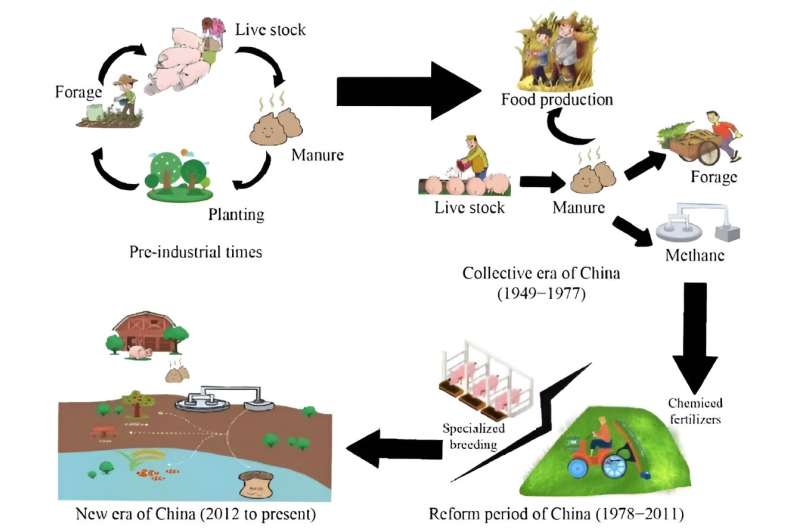This article has been reviewed according to Science X's editorial process and policies. Editors have highlighted the following attributes while ensuring the content's credibility:
fact-checked
proofread
Exploring the integration of crops and livestock in different historical contexts from ancient times to the present

Crop–livestock integration, the practice of combining crop planting and livestock breeding, is recognized as a fundamental approach to fostering a circular and green economy in agriculture.
Throughout China's agricultural development history, the concept of crop–livestock integration has played a pivotal role in enabling the nation to sustainably provide for its expanding population, despite the constraints of limited arable land. Nevertheless, as agricultural production methods have evolved, the development of crop–livestock integration has undergone dynamic transformations.
Associate researchers Danmeng Feng and Yu Hu from the Research Center for Rural Economy Ministry of Agriculture and Rural Affairs, along with their team, collaborated with Professor KouRay Mao from Colorado State University to explore the historical evolution of crop–livestock integration for sustainable agriculture in China from the perspectives of state policy goals, reform opportunities, and institutional constraints. Their research is published in the journal Frontiers of Agricultural Science and Engineering.
Extensive examination of existing literature has unearthed the roots of crop–livestock integration dating back to the Western Zhou Dynasty (1046 B.C.–771 B.C.), ultimately culminating in a multifaceted and intricately woven system of rural development policies seen in contemporary China.
This study identifies and characterizes four distinct stages in the historical trajectory of crop–livestock integration: the era of self-sufficient subsistence production in traditional times (1046 B.C.–1948); the period where crop–livestock integration emerged as a pivotal strategy for augmenting grain and meat production under collectivist policies (1949–1977); the phase marked by the industrialization and expansion of the livestock sector during the early years of economic reforms (1978–2011); and the present era in which crop–livestock integration is harnessed as a mechanism for pollution control and ecological preservation in contemporary China (2012–present).
As human civilization advanced and agriculture developed, the exchange of substances and energy between crop planting and livestock breeding became increasingly significant. Historically, farmers employed various methods of pen-raising sheep, pigs, or cattle to produce valuable manure fertilizers. The cyclic flow of nutrients and a commitment to environmental stewardship formed the bedrock of food productivity maintenance. Consequently, an array of distinct integration techniques evolved over time, drawing upon the creation and preservation of traditional knowledge and customs.
With the establishment of the People's Republic of China (PRC), rapid economic growth and a burgeoning population have generated heightened demands for both the quantity and quality of food production. The introduction of concentrated husbandry and specialization has disrupted traditional crop–livestock integration, resulting in a range of challenges for non-point source pollution control. These issues encompass the improper use of chemical fertilizers, livestock-related manure pollution, and significant misallocation of agricultural resources. Consequently, both agricultural resources and rural environments face substantial pressures.
Acknowledging the imperative of sustainable development, the Chinese Central government incorporated the concept of ecological civilization into its national development and environmental protection agendas in 2012. Subsequently, a series of government policies has been implemented to provide state support for crop–livestock integration and the promotion of a circular economy. These policies encompass initiatives focused on non-point-source pollution mitigation, the encouragement of green agricultural production, and intensified efforts to combat pollution. During this period, a market-driven new era of crop–livestock integration cycle mechanism was gradually established.
This study sheds light on the diverse roles played by crop–livestock integration in different epochs of rural development within China, which contributes to a nuanced and more theoretically grounded comprehension of circular agriculture. This understanding has the potential to be leveraged to promote sustainable rural development in broader contexts.
More information: Danmeng FENG et al, Crop-livestock integration for sustainable agriculture in China: the history of state policy goals, reform opportunities and institutional constraints, Frontiers of Agricultural Science and Engineering (2023). DOI: 10.15302/J-FASE-2023525
Provided by Frontiers Journals


















